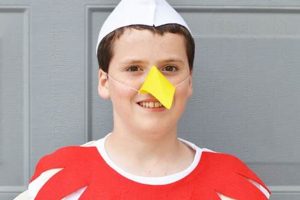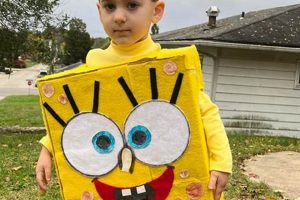Creating insect-themed attire at home involves the design and construction of garments and accessories that mimic the appearance of a bumble bee. This undertaking typically encompasses selecting suitable materials, such as black and yellow fabric, crafting wings from wire and sheer material, and assembling these components to form a recognizable representation of the insect. The practice often involves repurposing existing clothing items or utilizing crafting supplies to achieve the desired aesthetic.
The advantages of creating these types of costumes independently include cost savings compared to purchasing pre-made options, personalization of the design to suit individual preferences, and the satisfaction derived from a creative endeavor. The movement towards homemade clothing, including costumes, has historical roots in periods of resource scarcity and a broader cultural emphasis on self-sufficiency and artistic expression. It also reflects a growing awareness of sustainable practices through upcycling and waste reduction.
The subsequent sections will delve into specific techniques for constructing various components of insect-themed homemade attire, detailing material selection, assembly methods, and safety considerations. Furthermore, variations in design, tailoring the costume for different age groups, and methods for achieving a professional finish will be explored.
Essential Tips for Crafting a Bumble Bee-Inspired Attire
The following guidelines offer practical advice to ensure the successful creation of a visually appealing and durable bumble bee-themed costume.
Tip 1: Fabric Selection is Paramount: Opt for durable fabrics such as felt or fleece in black and yellow to ensure longevity and visual authenticity. Lightweight cotton fabrics can be used for lining, enhancing comfort.
Tip 2: Wing Construction Requires Precision: Craft the wings using wire as a frame and stretch sheer fabric, such as tulle or organza, over the frame. Secure the fabric tightly to prevent sagging and maintain the desired shape.
Tip 3: Stripe Uniformity is Critical: Maintain consistent stripe widths on the body of the costume to achieve a visually balanced appearance. Use a measuring tool to mark stripes before cutting or attaching fabric.
Tip 4: Stinger Attachment Demands Secure Fastening: When adding a stinger, ensure it is firmly attached to the costume’s rear to prevent detachment. Stitching and adhesive reinforcement are recommended.
Tip 5: Antennae Stability is Essential: Construct antennae using sturdy wire or pipe cleaners, securely fastened to a headband or hat. Ensure the antennae are positioned symmetrically for a balanced aesthetic.
Tip 6: Prioritize Comfort and Mobility: Design the attire to allow for ease of movement and comfortable wear. Avoid overly restrictive designs or bulky elements that hinder mobility.
Tip 7: Safety Considerations are Non-Negotiable: Eliminate any potential hazards, such as sharp edges on wings or unsecured embellishments, to ensure the wearer’s safety.
Adherence to these guidelines contributes to the creation of a visually appealing, durable, and safe costume, suitable for various occasions.
The subsequent section will provide detailed instructions on the specific assembly process and advanced design considerations.
1. Material Selection
The selection of appropriate materials is a foundational element in the successful execution of any do-it-yourself bumble bee costume. This process directly influences the costume’s aesthetic appeal, durability, comfort, and safety. Careful consideration must be given to the properties of each material to ensure the final product meets the required standards.
- Fabric Type and Weight
The choice between felt, fleece, cotton, or other fabrics impacts the costume’s overall weight, warmth, and drape. Heavier fabrics like felt offer structure and durability, while lighter fabrics like cotton provide breathability and comfort. The selection must balance aesthetic requirements with practical considerations for the wearer.
- Color Fastness and Dye Quality
The color fastness of the chosen materials is crucial for maintaining the costume’s visual integrity. Fabrics with poor dye quality are susceptible to fading or bleeding, compromising the bumble bee’s characteristic black and yellow stripes. Selecting materials known for their color retention ensures a longer-lasting and more vibrant costume.
- Wing Material Properties
The construction of the bumble bee’s wings requires lightweight yet sturdy materials. Sheer fabrics like tulle or organza are commonly used, but their tear resistance and ability to hold their shape are critical. Wire or alternative framing materials must be chosen for their flexibility and strength to support the fabric and maintain the wing’s form.
- Fastener and Embellishment Compatibility
The selection of fasteners, such as zippers, Velcro, or snaps, must be compatible with the chosen fabrics. Heavy-duty fasteners may be necessary for thicker materials, while more delicate options are suitable for lighter fabrics. Similarly, any embellishments, such as pom-poms or antennae materials, must be securely attached to prevent detachment and potential safety hazards.
Ultimately, the materials chosen determine the overall quality and longevity of the insect-themed attire. Prioritizing durable, colorfast, and safe materials ensures a final product that effectively captures the desired aesthetic while providing a comfortable and secure wearing experience. The selection process is a critical step in transforming the concept into a tangible and wearable representation.
2. Wing Construction
Wing construction represents a critical component in the creation of a do-it-yourself bumble bee costume. The visual recognizability of a bumble bee heavily relies on the presence and design of its wings; therefore, the quality of their construction directly influences the costume’s overall success. Inadequate wing construction, characterized by flimsy materials or disproportionate sizing, detracts from the costume’s intended effect. Conversely, well-constructed wings, exhibiting appropriate shape, size, and secure attachment, enhance the costume’s realism and aesthetic appeal. For example, wings crafted from loosely woven material may droop, misrepresenting the insect’s form, while properly formed wings utilizing wire frames and taut fabric provide a more accurate depiction.
Practical applications of proper wing construction extend beyond mere aesthetics. Securely attached wings are essential for the wearer’s comfort and safety, preventing detachment that could lead to tripping or entanglement. Furthermore, the choice of lightweight materials ensures
the wearer’s mobility is not unduly restricted. The selection of materials also impacts the durability of the costume; robust materials contribute to the longevity of the wings, allowing for repeated use. A notable example can be seen in children’s costumes, where durable wing construction is crucial to withstand the wear and tear associated with active play. The crafting process also presents opportunities for creative expression, enabling the incorporation of decorative elements such as glitter or vein patterns to further enhance the costume’s visual interest.
In summary, wing construction holds significant importance in the context of homemade bumble bee attire. Attending to the selection of appropriate materials, structural integrity, and secure attachment translates to a visually compelling, durable, and safe costume. Overlooking these factors undermines the costume’s effectiveness and potentially compromises the wearer’s comfort and safety. Thus, prioritizing wing construction stands as a fundamental principle in the successful realization of a DIY bumble bee costume.
3. Stripe Application
The application of stripes to a do-it-yourself bumble bee costume is not merely a decorative step, but a fundamental element in achieving visual authenticity and recognizability. The alternating black and yellow stripes are the defining characteristic of the bumble bee, and their accurate representation is critical for conveying the intended subject of the costume. Inaccurate stripe application, characterized by inconsistent widths, irregular spacing, or incorrect color placement, detracts significantly from the overall effect, potentially leading to misidentification of the costume’s subject. For example, stripes that are too wide or uneven can create a distorted appearance, while omitting the stripes altogether would render the costume unrecognizable as a bumble bee.
The stripe application process also presents practical considerations related to material selection, construction techniques, and durability. Depending on the chosen methodwhether painting, sewing fabric strips, or using adhesive tapethe materials and techniques must be carefully selected to ensure longevity and resistance to wear and tear. Sewn fabric strips, for instance, offer a durable and professional finish but require significant time and skill to execute. Painted stripes, while quicker to apply, may be susceptible to cracking or fading with repeated use. Adhesive tape provides a temporary solution but lacks the durability required for sustained wear. The stripe application method directly influences the costume’s overall quality and its ability to withstand the demands of use, particularly in children’s costumes that are subject to more rigorous activity.
In conclusion, the stripe application phase holds paramount importance in the DIY bumble bee costume creation process. It constitutes a direct visual link to the bumble bee’s defining features. Thoughtful planning is essential, emphasizing material selection and implementation methods to ensure accurate representation. It is a vital component contributing to the costume’s aesthetic success and practical durability. This effort ultimately delivers a clear image and a lasting and recognizable depiction.
4. Antennae Design
Antennae design is a critical element in the construction of insect-themed attire, specifically within the context of a do-it-yourself bumble bee costume. These appendages contribute significantly to the recognizability and authenticity of the costume, functioning as a visual cue that immediately identifies the wearer as a bumble bee. The design and execution of the antennae, therefore, warrant careful consideration to ensure they accurately represent the insect’s characteristics and enhance the overall aesthetic.
- Material Selection and Structural Integrity
The selection of appropriate materials is paramount in achieving the desired aesthetic and ensuring the antennae’s structural integrity. Common materials include wire, pipe cleaners, fabric, and foam. Wire provides flexibility and shape retention, while pipe cleaners offer a softer, more tactile option. The chosen material must be durable enough to withstand handling and movement without bending or breaking. For example, thin gauge wire may be unsuitable for larger antennae due to its lack of rigidity, while thicker gauge wire may be difficult to shape. The structural integrity directly impacts the costume’s longevity and the wearer’s comfort.
- Attachment Method and Stability
The method of attaching the antennae to the wearer’s head is a crucial factor in their stability and wearability. Common attachment methods include headbands, hats, or direct attachment to the costume’s hood. The attachment must be secure enough to prevent the antennae from shifting or falling off during movement. Furthermore, the attachment point must be comfortable for the wearer to avoid irritation or discomfort. For instance, a poorly attached headband may cause pressure points, while an insecure hat may slip and obstruct vision. The attachment method directly influences the wearer’s experience and the costume’s practicality.
- Shape and Proportionality
The shape and proportionality of the antennae relative to the overall costume contribute significantly to its visual accuracy. Bumble bee antennae are typically characterized by their relatively short length and slightly curved shape. Exaggerated or disproportionate antennae can detract from the costume’s realism and undermine the intended effect. The antennae should be sized appropriately to complement the wearer’s head size and the overall dimensions of the costume. For example, excessively long antennae may appear comical or cumbersome, while overly small antennae may be barely noticeable. Accurate shape and proportionality are essential for conveying the intended visual message.
- Aesthetic Details and Embellishments
Aesthetic details and embellishments can further enhance the visual appeal of the antennae and add a touch of personalization to the costume. Common embellishments include fabric coverings, paint, and decorative elements such as pom-poms or glitter. These details can be used to mimic the texture and coloration of real bumble bee antennae or to add a creative flair to the costume. However, it is important to ensure that any embellishments are securely attached and do not pose a safety hazard. For example, loosely attached glitter may fall off and create a mess, while sharp embellishments may cause injury. Thoughtful aesthetic details can elevate the costume’s overall appearance and demonstrate attention to detail.
The design and execution of antennae are integral to constructing effective do-it-yourself bumble bee attire. The choice of materials, construction methods, and aesthetic details significantly impacts the visual accuracy, durability, and wearability of the costume. Careful consideration of these factors ensures that the antennae contribute positively to the overall aesthetic and enhance the wearer’s experience. The attention to detail when creating antennae ultimately delivers a compelling and recognizable depiction.
5. Safety Measures
The creation of a homemade bumble bee costume necessitates diligent attention to safety measures. Neglecting this aspect can result in hazards, ranging from minor discomfort to more serious injuries. Sharp edges on wing frames, loosely attached embellishments, and flammable materials pose significant risks to the wearer. For example, a wire wing frame lacking proper sheathing could cause lacerations, while easily detached pom-poms present a choking hazard, particularly for young children. Material selection is crucial; using inherently flammable fabrics near open flames creates a dangerous scenario. Therefore, integrating safety considerations throughout the design and construction process is paramount.
Practical application of safety measures involves several key steps. Employing blunt-tipped scissors and needles minimizes the risk of accidental cuts and punctures during assembly. Selecting non-toxic, water-based paints and adhesives reduces the likelihood of skin irritation or allergic reactions. Securing all embellishments, such as buttons or sequins, with robust stitching or industrial-strength adhesive ensures they remain firmly attached. Choosing inherently fire-resistant fabrics, such as treated cotton or synthetic blends, mitigates the risk of combustion. Moreover, rigorous testing of the completed costume for potential hazards, such as protruding elements or restricted movement, identifies and addresses any remaining safety concerns.
In summary, the intersection of safety measures and do-it-yourself bumble bee costume construction demands proactive risk mitigation. Overlooking safety protocols can lead to preventable injuries. Conversely, prioritizing safety through careful material selection, secure assembly techniques, and thorough hazard assessment significantly enhances the costume’s overall safety and suitability for wear. These safety measure is a primary and essential part to do it.
Frequently Asked Questions About DIY Bumble Bee Costumes
The following addresses common inquiries regarding the construction and safety of homemade bumble bee costumes. These answers are intended to provide clear and concise information to assist individuals in creating a safe and visually appealing costume.
Question 1: What fabric types are most suitable for constructing a durable and visually appealing bumble bee costume?
Durable fabrics such as felt or fleece are recommended for the main body of the costume. These materials offer resistance to wear and tear and provide a solid base for attaching stripes and other embellishments. Lightweight cotton can be used for lining to enhance comfort.
Question 2: How can the wings of a bumble bee costume be constructed to ensure stability and visual accuracy?
Construct wings using a wire frame covered with sheer fabric such as tulle or organza. Ensure the wire frame is securely fastened and the fabric is tautly stretched to maintain the desired shape. Consider using multiple layers of fabric for added stability.
Question 3: What is the recommended method for attaching stripes to a bumble bee costume to ensure longevity?
Sewing fabric stripes directly onto the costume is the most durable method. Ensure that the seams are reinforced to prevent fraying or detachment. Fabric glue can be used for temporary applications, but sewing is recommended for long-term wear.
Question 4: What considerations should be taken into account when designing the antennae for a bumble bee costume to prevent injury?
Construct the antennae from flexible materials such as pipe cleaners or soft wire. Securely attach the antennae to a headband or hat using a strong adhesive or stitching. Avoid sharp points or edges that could pose a hazard.
Question 5: What steps should be taken to ensure the overall safety of a homemade bumble bee costume, particularly for children?
Eliminate any small, detachable parts that could be ingested, such as buttons or beads. Ensure that the costume allows for freedom of movement and does not restrict breathing or vision. Use fire-resistant fabrics whenever possible.
Question 6: How can the colorfastness of fabric be tested to ensure the stripes remain vibrant over time?
Test a small, inconspicuous area of the fabric by washing it with a mild detergent. If the color bleeds or fades, pre-treat the fabric with a color-setting agent before constructing the costume.
Adhering to these guidelines contributes to the creation of a safe, durable, and visually appealing homemade bumble bee costume. Proper planning and execution are essential for achieving a successful outcome.
The subsequent section will provide detailed instructions on specific assembly techniques and advanced design considerations for creating bumble bee costumes.
DIY Bumble Bee Costume
This exploration has illuminated the critical factors involved in crafting insect-themed attire at home, emphasizing material selection, construction techniques, and safety protocols. The creation of a visually appealing and durable representation necessitates careful attention to detail, ensuring that the final product accurately reflects the intended subject. Consideration of fabric type, wing construction methods, stripe application precision, antennae design, and adherence to safety regulations are paramount.
Successful execution extends beyond mere aesthetics, encompassing functionality, comfort, and, most importantly, safety. The information presented serves as a comprehensive guide for individuals undertaking this creative endeavor. Adherence to these principles will ensure a successful undertaking that meets its visual aims, while prioritizing the well-being of the wearer. This comprehensive understanding not only enhances the quality of the final product but also contributes to a more informed and responsible approach to costume design.







